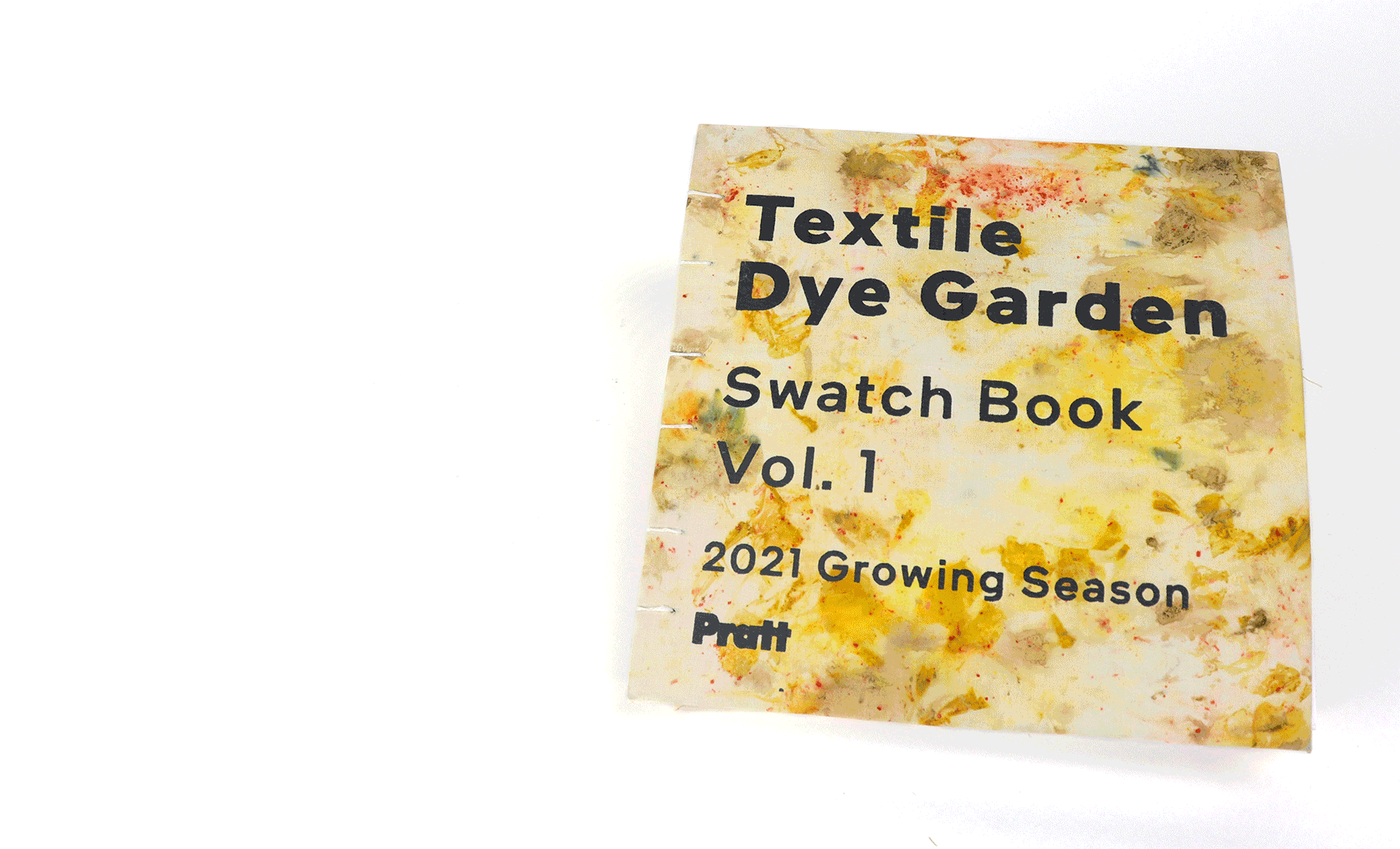New in the lab: the textile dye garden 2021 swatch book
Sarah Burry (MSLIS/MA History of Art and Design ’23) interviews Ana Codorean (MA Art and Design Education ‘22) about the Material Lab’s latest acquisition.
Above: The Textile Dye Garden 2021 Swatchbook, vol. 1 was created to document the garden’s first growing season.
The return to campus in Fall of 2021 came with several exciting and collaborative projects. With generous support from The Hazel Siegel Textile Dye Garden Exploration Fund, students and the faculty leader Professor Gina Gregorio maintained a sprawling garden at the Brooklyn Campus’ Cannoneer Court and harvested plants and flowers prized for their use in natural dyeing.
The culmination of the harvest took form in the Textile Dye Garden 2021 Swatch Books, a copy of which now resides in the Material Lab. Featuring over 180 samples of hand-dyed cotton, linen, wool, and silk, the Swatch Book also documents the plants, recipes, and research used over the course of the growing season. Material Lab Graduate Assistant Sarah Burry sat down with Textile Dye Garden Graduate Assistant Ana Codorean to talk about the process of the project. Highlights from our talk are below.
Above: The Swatchbook was the project of Professor & 2022 CPT Fellow Gina Gregorio and graduate assistant Ana Codorean.
SB: Can you begin by introducing yourself and your academic focus at Pratt?
AC: My name is Ana Codorean and I am a first-year graduate student studying Art and Design Education at Pratt.
SB: Tell us about the Textile Dye Garden and how you got involved.
AC: The Textile Dye Garden started the Spring before I came to Pratt. It was founded by the School of Design’s Fashion and Textile Department– specifically Gina Gregorio, who is faculty in the Fashion Department & Textile Minor. I know her from my undergraduate study in Textiles at RISD. She knew I was coming to Pratt and we thought it would be a great fit for me to join the Garden and combine my textiles knowledge with my education studies to work on the learning programs at the garden.
SB: What are some of the roles you play in the Garden?
AC: The swatch book was a major project I worked on with all the work study students. I did all the formatting and printing of the book, and bound it with Gina. We were thinking about how to outreach to people within Pratt, and hopefully, outside of Pratt in the larger community. Because of Covid we haven’t been able to open our events up, but doing event programming has been a large part of my job. One of the big things I did last semester was get our website up, which made our aggregated research and experimentation accessible to anyone at Pratt and beyond. So my main responsibility is teaching people about dyes in the garden, in multiple forms.
SB: And the Swatch Book itself was bound for the use of Pratt Researchers. What was the impetus of its creation and how did you get it made?
AC: We had lots of dried yield from the 2021 growing season and wanted to document it in a way that was consistent, so you could see the dye on the same fabrics with the same techniques year to year, as we add more volumes to our collection. The work-study undergraduate students dyed all the fabrics. I designed the swatch book to be simple and straightforward, but also full of information about traditional uses for the plants, as a lot of them have been used historically not just for dyeing, but medicinally, or for food or other purposes. Then we wrote about how we grew each plant, including any gardening tips, and had it printed at the imaging center. We bound it in a swatch we made at one of our bundle dye events. And we also included swatches from other events we did, like bundle dye and fresh leaf indigo dye.
SB: That was my next question! Throughout this process, what events have you held for the Pratt Community?
AC: Last fall we held several events. We hope to do more this Spring, once the weather warms up a bit and we can have people comfortably outside. We had an event recently as part of Pratt’s Earth Action Week. We made pigments for painting out of our harvest for last fall. I think we want to continue doing events, but one of our goals is to involve more departments outside of textile and fashion. We want people in Foundations, Industrial Design, or any other program to learn about natural dyes and implement them in their studies.
SB: Yes, I saw on your instagram someone was using both the dye and modifiers as watercolors for painting.
AC: Yeah, I actually did those watercolor paintings one day-
SB: They were lovely!
AC: Oh, thanks! Using them as paints was very gratifying because when you use modifiers, the color changes before your eyes as you’re painting. We would love to get the Fine Arts Department involved in using our pigments— and not even necessarily ours! Just learning about natural pigments and maybe using that in their practice. We have an interest in using them for screen printing. The Foundations Lab is essentially a nature lab with all sorts of specimens objects for students to look at and draw from and be inspired from, so we would love to work with them in the future. We had some Industrial Design students reach out about wanting to dye wood with natural dyes, because wood stains can be very toxic. We’ve also had some Landscape Design students interested in working on a water collection system in the garden, so the garden would serve not just as a place for natural dyes but also a lab for urban gardening and sustainable horticulture practices
Above: Pigments made from plants like Yellow Dahlia, Black-eyed Susan, Bee Balm, and Japanese Indigo were used to dye swatches of linen, silk, and wool.
SB: How can students who see the Textile Swatch Book in the Material Lab get involved?
AC: We have our website, and every time we have an event we make sure to document it really well. That way even if they can’t be there, they can learn about the process and even try it at home. Our instagram @prattdyegarden is a great way to get in touch. People ask about their own project ideas, wanting to use natural dyes with a unique approach, or wanting to get involved in the garden through composting or other ways. We encourage anyone who has an idea relating to gardens or natural dyes to reach out to us on instagram or our email and see if we can collaborate.
SB: Well this book is so beautiful, and I’m so glad that it’s now in the lab.
AC: Thanks. We just really want to encourage more people to visit and get involved. We're very open to other people's ideas.
The Textile Dye Garden Swatch Book vol. 1 is on view in the Material Lab special collections. The Material Lab is open in ENG 005 from 9 AM - 6 PM Monday-Friday.




